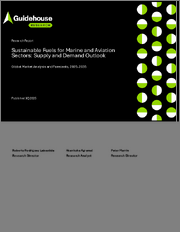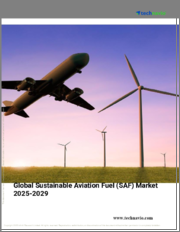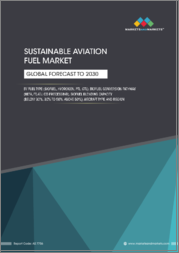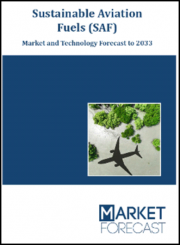
|
시장보고서
상품코드
1666972
지속가능한 항공 연료 시장 기회, 성장 촉진요인, 산업 동향 분석, 예측(2025-2034년)Sustainable Aviation Fuel Market Opportunity, Growth Drivers, Industry Trend Analysis, and Forecast 2025 - 2034 |
||||||
전 세계 지속가능한 항공 연료 시장은 2024년 17억 달러로 평가되며 2025년부터 2034년까지 연평균 46.2%의 높은 성장률을 기록할 것으로 예상됩니다.
항공 부문이 환경 발자국을 최소화해야 한다는 압박에 직면하면서 SAF는 필수적인 솔루션으로 부상하고 있습니다. SAF는 바이오매스, 농업 잔재, 폐유 등 재생 가능한 자원에서 추출한 연료로 기존 제트 연료에 비해 이산화탄소 배출량을 크게 줄일 수 있습니다.
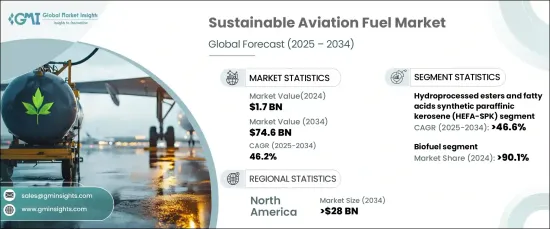
환경 문제에 대한 인식이 높아짐에 따라 항공사와 승객들은 보다 친환경적인 대체 연료를 선호하고 있으며, SAF는 항공사가 지속가능성 목표를 달성하고, 환경 평가를 높이고, 국제적인 이산화탄소 감축 의무를 준수할 수 있도록 지원할 것입니다. 이러한 변화는 SAF의 생산과 친환경 항공 기술에 대한 투자를 촉진할 것으로 예상됩니다. 수요 증가는 생산능력과 기술 혁신을 촉진하고 항공 산업을 변화시키는 데 있어 SAF의 역할을 더욱 강화할 것으로 보입니다.
| 시장 범위 | |
|---|---|
| 시작 연도 | 2024년 |
| 예측 연도 | 2025-2034년 |
| 시작 금액 | 17억 달러 |
| 예상 금액 | 746억 달러 |
| CAGR | 46.2% |
각국 정부는 항공이 환경에 미치는 영향을 줄이기 위한 전략을 시행하고 있으며, SAF의 생산, 채택 및 기술 혁신을 촉진하기 위한 정책이 확산되면서 이 분야의 성장을 가속화하고 있습니다. 세제 혜택, 보조금 및 기타 자금 지원 프로그램은 지속가능한 항공 기술의 발전을 촉진하는 동시에 전 세계 기후 변화 목표 달성을 지원하고 있습니다.
연료의 종류에 따라 SAF 시장은 바이오연료, 수소 연료, 액체연료, 가스액화연료로 구분됩니다. 바이오연료는 2024년 90.1% 이상의 점유율로 시장을 독점하고 있습니다. 식물성 기름이나 농업 잔류물과 같은 생물학적 물질로 제조되는 바이오연료는 기존의 제트 연료를 대체할 수 있는 청정 연료입니다. 이러한 연료는 기존 항공기 엔진에 큰 변화를 주지 않고 기존 제트 연료와 혼합할 수 있기 때문에 항공 분야의 배출량 감축을 위한 현실적인 대안이 될 수 있습니다. 그 개발은 다양한 원료 선택과 생산 기술의 발전으로 뒷받침되고 있습니다.
기술적으로는 수첨 에스테르-지방산 합성 파라핀 케로신(HEFA-SPK), 피셔-트롭쉬 합성 파라핀 케로신(FT-SPK), 알코올-제트 합성 파라핀 케로신(ATJ-SPK) 및 기타 방법들이 시장에 출시되어 있습니다. HEFA-SPK는 폐유 및 유지 등의 원료를 사용하여 고품질 드롭인 연료를 제조하는 높은 적합성과 확장성으로 선두를 달리고 있으며, HEFA-SPK는 다재다능하고 기존 항공 인프라와의 호환성이 높아 지속가능성 목표 달성에 크게 기여하고 있습니다.
북미는 SAF 시장을 독점하고 있으며, 2034년까지 280억 달러 이상에 달할 것으로 예상됩니다. 강력한 정책, 기술 발전, 투자가 특히 미국을 중심으로 이 지역의 성장을 주도하고 있습니다. 이 지역의 SAF 개발 리더십은 배출량 감축과 친환경 항공 기술 발전에 대한 광범위한 노력을 반영하고 있습니다.
목차
제1장 조사 방법과 조사 범위
- 시장 범위와 정의
- 기본 추정과 계산
- 예측 계산
- 데이터 소스
- 1차 데이터
- 2차 데이터
- 유료 정보 출처
- 공적 정보 출처
제2장 주요 요약
제3장 업계 인사이트
- 생태계 분석
- 밸류체인에 영향을 미치는 요인
- 이익률 분석
- 파괴
- 향후 전망
- 제조업체
- 유통업체
- 공급업체 상황
- 이익률 분석
- 주요 뉴스
- 규제 상황
- 영향요인
- 성장 촉진요인
- 지속가능한 항공 연료 솔루션에 대한 수요 증가
- 세계의 그린 항공 이니셔티브를 지원하는 정부 정책
- SAF 제조 기술과 효율 향상
- 재생에너지 및 항공 분야에 대한 투자 증가
- 친환경 항공 여행에 대한 소비자 기호 상승
- 업계의 잠재적 리스크와 과제
- 지속가능한 항공 연료의 높은 제조 비용
- SAF 생산에 이용 가능한 원료가 한정
- 성장 촉진요인
- 성장 가능성 분석
- Porters 분석
- PESTEL 분석
제4장 경쟁 구도
- 소개
- 기업 점유율 분석
- 경쟁 포지셔닝 매트릭스
- 전략 전망 매트릭스
제5장 시장 추정과 예측 : 연료 유형별, 2021-2034년
- 주요 동향
- 바이오연료
- 수소 연료
- 파워 투 리퀴드
- 가스 투 리퀴드
제6장 시장 추정과 예측 : 기술별, 2021-2034년
- 주요 동향
- 수소화 에스테르·지방산 합성 파라핀 등유(HEFA-SPK)
- 피셔-트롭쉬 합성 파라핀 등유(FT-SPK)
- 발효 수소 첨가당에서 합성 이소파라핀(HFS-SIP)
- 알코올-제트 합성 파라핀 등유(ATJ-SPK)
- 촉매적 가수분해 제트(CHJ)
제7장 시장 추정과 예측 : 블렌드 용량별, 2021-2034년
- 주요 동향
- 30% 미만
- 30%-50% 미만
- 50% 이상
제8장 시장 추정과 예측 : 최종 용도별, 2021-2034년
- 주요 동향
- 항공사
- 대형 항공사
- 중견 항공사
- 소규모 항공사
- 비정기 운항 항공사
- 정부/군사
제9장 시장 추정과 예측 : 지역별, 2021-2034년
- 주요 동향
- 북미
- 미국
- 캐나다
- 유럽
- 영국
- 독일
- 프랑스
- 이탈리아
- 스페인
- 러시아
- 아시아태평양
- 중국
- 인도
- 일본
- 한국
- 호주
- 라틴아메리카
- 브라질
- 멕시코
- 중동 및 아프리카
- 남아프리카공화국
- 사우디아라비아
- 아랍에미리트
제10장 기업 개요
- Aemetis, Inc.
- Alder Energy, LLC
- Amyris
- BP Plc
- Cemvita
- DG Fuels
- Fulcrum BioEnergy Inc.
- Gevo Inc.
- LanzaJet
- Neste
- Northwest Advanced Bio-Fuels, LLC
- OMV Aktiengesellschaft
- Preem AB
- Red Rock Biofuels
- SAF Plus International Group
- Sasol Corporation
- Shell
- SkyNRG BV
- TotalEnergies SE
- USA BioEnergy
- WasteFuel
- World Energy
The Global Sustainable Aviation Fuel Market was valued at USD 1.7 billion in 2024 and is projected to grow at a remarkable CAGR of 46.2% from 2025 to 2034. As the aviation sector faces mounting pressure to minimize its environmental footprint, SAF is emerging as a vital solution. These fuels are derived from renewable sources such as biomass, agricultural residues, and waste oils, offering a significantly reduced carbon footprint compared to traditional jet fuels.

Growing awareness of environmental issues has prompted airlines and passengers alike to favor greener alternatives. SAF supports airlines in meeting sustainability objectives, enhancing environmental ratings, and aligning with international carbon-reduction mandates. This shift is expected to drive investments in SAF production and green aviation technologies. Increasing demand will likely boost production capacity and innovation, further solidifying SAF's role in transforming the aviation industry.
| Market Scope | |
|---|---|
| Start Year | 2024 |
| Forecast Year | 2025-2034 |
| Start Value | $1.7 Billion |
| Forecast Value | $74.6 Billion |
| CAGR | 46.2% |
Governments around the world are implementing strategies to mitigate the environmental impact of aviation. Policies aimed at promoting SAF production, adoption, and innovation are becoming widespread, accelerating the sector's growth. Tax incentives, subsidies, and other funding programs are helping to achieve global climate targets while fostering advancements in sustainable aviation technologies.
In terms of fuel types, the SAF market is segmented into biofuels, hydrogen fuel, power-to-liquid, and gas-to-liquid. Biofuels dominate the market with over 90.1% of the share in 2024. Produced from biological materials like plant oils and agricultural residues, biofuels represent a cleaner alternative to conventional jet fuels. These fuels can be blended with traditional jet fuels without significant changes to existing aircraft engines, making them a practical choice for reducing emissions in the aviation sector. Their development is supported by diverse feedstock options and advancements in production techniques.
Technologically, the market includes hydroprocessed esters and fatty acids synthetic paraffinic kerosene (HEFA-SPK), Fischer-Tropsch synthetic paraffinic kerosene (FT-SPK), alcohol-to-jet synthetic paraffinic kerosene (ATJ-SPK), and other methods. HEFA-SPK leads with its high compatibility and scalability, using feedstocks such as waste oils and fats to produce a high-quality, drop-in fuel. Its versatility and alignment with existing aviation infrastructure make it a key contributor to sustainability goals.
North America is anticipated to dominate the SAF market, reaching over USD 28 billion by 2034. Robust policies, technological advancements, and investments are driving regional growth, particularly in the US. The region's leadership in SAF development reflects a broader commitment to reducing emissions and advancing green aviation technologies.
Table of Contents
Chapter 1 Methodology & Scope
- 1.1 Market scope & definitions
- 1.2 Base estimates & calculations
- 1.3 Forecast calculations
- 1.4 Data sources
- 1.4.1 Primary
- 1.4.2 Secondary
- 1.4.2.1 Paid sources
- 1.4.2.2 Public sources
Chapter 2 Executive Summary
- 2.1 Industry synopsis, 2021-2034
Chapter 3 Industry Insights
- 3.1 Industry ecosystem analysis
- 3.1.1 Factor affecting the value chain
- 3.1.2 Profit margin analysis
- 3.1.3 Disruptions
- 3.1.4 Future outlook
- 3.1.5 Manufacturers
- 3.1.6 Distributors
- 3.2 Supplier landscape
- 3.3 Profit margin analysis
- 3.4 Key news & initiatives
- 3.5 Regulatory landscape
- 3.6 Impact forces
- 3.6.1 Growth drivers
- 3.6.1.1 Increasing demand for sustainable aviation fuel solutions
- 3.6.1.2 Government policies supporting green aviation initiatives globally
- 3.6.1.3 Advancements in SAF production technology and efficiency
- 3.6.1.4 Rising investments in renewable energy and aviation sectors
- 3.6.1.5 Growing consumer preference for eco-friendly air travel
- 3.6.2 Industry pitfalls & challenges
- 3.6.2.1 High production costs of sustainable aviation fuels
- 3.6.2.2 Limited availability of feedstock for SAF production
- 3.6.1 Growth drivers
- 3.7 Growth potential analysis
- 3.8 Porter’s analysis
- 3.9 PESTEL analysis
Chapter 4 Competitive Landscape, 2024
- 4.1 Introduction
- 4.2 Company market share analysis
- 4.3 Competitive positioning matrix
- 4.4 Strategic outlook matrix
Chapter 5 Market Estimates & Forecast, By Fuel Type, 2021-2034 (USD Million & Gallons)
- 5.1 Key trends
- 5.2 Biofuel
- 5.3 Hydrogen fuel
- 5.4 Power-to-Liquid
- 5.5 Gas-to-Liquid
Chapter 6 Market Estimates & Forecast, By Technology, 2021-2034 (USD Million & Gallons)
- 6.1 Key trends
- 6.2 Hydroprocessed Esters and Fatty Acids Synthetic Paraffinic Kerosene (HEFA-SPK)
- 6.3 Fischer-Tropsch Synthetic Paraffinic Kerosene (FT-SPK)
- 6.4 Synthetic Iso-Paraffins from Fermented Hydroprocessed Sugar (HFS-SIP)
- 6.5 Alcohol-to-Jet Synthetic Paraffinic Kerosene (ATJ-SPK)
- 6.6 Catalytic Hydrothermolysis Jet (CHJ)
Chapter 7 Market Estimates & Forecast, By Blending Capacity, 2021-2034 (USD Million & Gallons)
- 7.1 Key trends
- 7.2 Below 30%
- 7.3 30% to 50%
- 7.4 Above 50%
Chapter 8 Market Estimates & Forecast, By End Use, 2021-2034 (USD Million & Gallons)
- 8.1 Key trends
- 8.2 Airline
- 8.2.1 Large airline
- 8.2.2 Medium airline
- 8.2.3 Small airline
- 8.3 Non-scheduled operator
- 8.4 Government/military
Chapter 9 Market Estimates & Forecast, By Region, 2021-2034 (USD Million & Gallons)
- 9.1 Key trends
- 9.2 North America
- 9.2.1 U.S.
- 9.2.2 Canada
- 9.3 Europe
- 9.3.1 UK
- 9.3.2 Germany
- 9.3.3 France
- 9.3.4 Italy
- 9.3.5 Spain
- 9.3.6 Russia
- 9.4 Asia Pacific
- 9.4.1 China
- 9.4.2 India
- 9.4.3 Japan
- 9.4.4 South Korea
- 9.4.5 Australia
- 9.5 Latin America
- 9.5.1 Brazil
- 9.5.2 Mexico
- 9.6 MEA
- 9.6.1 South Africa
- 9.6.2 Saudi Arabia
- 9.6.3 UAE
Chapter 10 Company Profiles
- 10.1 Aemetis, Inc.
- 10.2 Alder Energy, LLC
- 10.3 Amyris
- 10.4 BP Plc
- 10.5 Cemvita
- 10.6 DG Fuels
- 10.7 Fulcrum BioEnergy Inc.
- 10.8 Gevo Inc.
- 10.9 LanzaJet
- 10.10 Neste
- 10.11 Northwest Advanced Bio-Fuels, LLC
- 10.12 OMV Aktiengesellschaft
- 10.13 Preem AB
- 10.14 Red Rock Biofuels
- 10.15 SAF Plus International Group
- 10.16 Sasol Corporation
- 10.17 Shell
- 10.18 SkyNRG BV
- 10.19 TotalEnergies SE
- 10.20 USA BioEnergy
- 10.21 WasteFuel
- 10.22 World Energy






